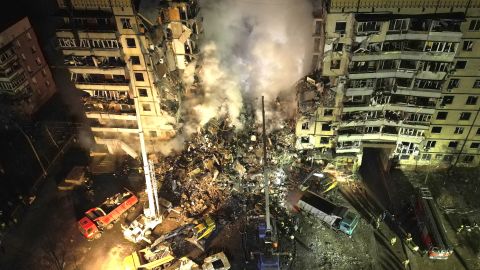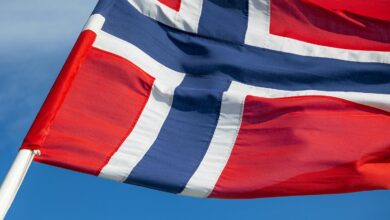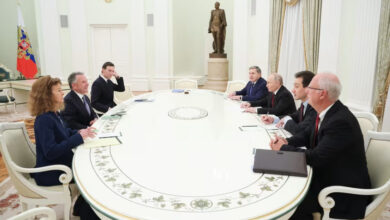
Missiles and explosions were heard everywhere from Lviv in the west; Kharkiv in the northeast; Zaporizhzhia and Dnipro in the southeast; Myokaliv in the south; and Kharkiv in the northeast, officials said.
In Dnipro, another 27 people, including six children, were hospitalized after being wounded in the apartment building strike, according to Valentyn Reznichenko, the head of the Dnipropetrovsk regional military administration.
Local authorities are working to dig people from the rubble but 26 remain trapped, according to Reznichenko. So far, at least 15 have been rescued, said Kyrylo Tymoshenko, an aide to Ukrainian President Volodymyr Zelensky.
“We are fighting for every person, every life,” Zelensky said on social media.
In his nightly address on Saturday, Zelensky said “dozens” of people, including a three-year-old girl, were rescued from the building even though most of the floors were “smashed” in the strike.

The Ukrainian Air Force said the Russian missile fired at the apartment block in Dnipro was a Kh-22 – the same type that hit a busy shopping mall in central Ukraine last summer.
Yurii Ihnat, spokesman for the Ukrainian air force, said the Kh-22 “was fired from a Tu-22M3 long-range bomber, launched from the area near Kursk and the Sea of Azov.”
“There were a total of five launches of these missiles,” Ihnat said.
The Kh-22 is an older type of cruise missile that is less accurate than most modern missiles.
Attack on the capital
Authorities in Kyiv said there was an “attack on the capital.” Blasts were heard as early as 6 a.m. local time, according to the head of Kyiv region military administration, Oleksiy Kuleba. Mayor Vitaliy Klitschko said strikes hit the city’s east bank, where several power facilities were located. The exact locations of the blasts could not be immediately verified by CNN. A thick fog blanketed much of the city.
However, Oleksandr Pavliuk, a Kyiv-based commander in the Ukrainian army, said the explosions in Kyiv were not caused by Russian attacks.
“The explosions are not connected with the threat from the air or air defense, as well as with any military actions,” Pavliuk wrote on the encrypted social media app Telegram. “If there was a threat – you would have heard the alarm. The cause of the explosions will be reported separately.”
Russia’s latest nationwide salvo appeared to target critical infrastructure across Ukraine, as the Kremlin continues its efforts to limit the country’s ability to heat and power itself in the middle of winter.
‘Fierce fighting’ in Soledar
On the battlefield, all eyes are fixed on Soledar, a town of little strategic value that Russia is attempting to retake in the hopes that it will provide Russian President Vladimir Putin a symbolic victory. Various units of the Ukrainian military said that Soledar remains the scene of “fierce fighting.” Russia’s Ministry of Defense claimed that its forces took control of the town, although Kyiv has denied it.
After a broad assessment regarding the situation on the ground in Ukraine, several Western governments have decided to answer Zelensky’s longstanding call to supply modern battle tanks to Kyiv.
France, Poland and the United Kingdom have pledged to soon send tanks for the Ukrainian military to use in its efforts to protect itself from Russia. Finland is considering following suit. Britain said it plans to send a dozen Challenger 2 tanks and additional artillery systems. Poland plans to send a company of German-built Leopard tanks while France will deliver its domestically built AMX 10-RCs.
CNN’s Julia Kesaieva, Josh Pennington and Mariya Knight contributed to this report.




